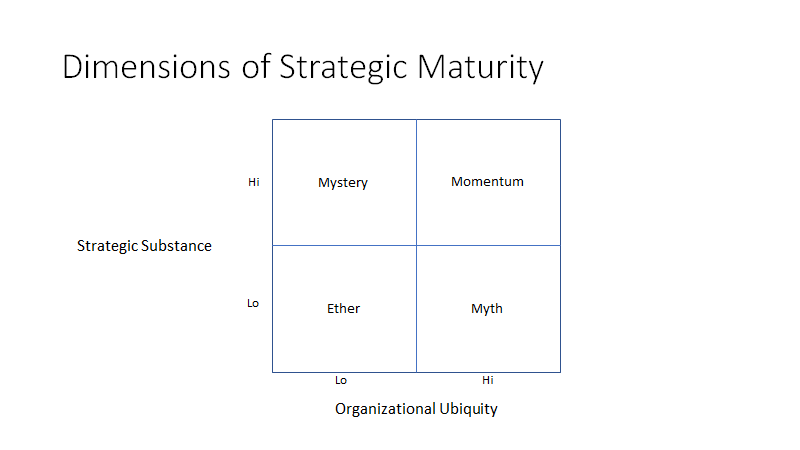Many of the companies we work with are led by the founder and visionary behind the company’s initial offering and wave of commercial success. Almost inevitably, these organizations need to discover a new gear in order to scale and sustain the business. The organization may continue to grow and otherwise experience success for some time. But there are limits to this founding operational model, and the realization of the limitations – often experienced through painful events such as financial under-performance, customer and employee attrition, or new product development failures – is the company’s first cry for “strategy.”
Leaders who respond to the cry and demonstrate the ability to formulate, express, and deploy strategy are far more likely to discover that next gear for growth and sustainability.
Now, “strategy” is a bit of an elusive concept. I love the 1991 quotation from The Economist: “Nobody really knows what strategy is.” Perhaps equally unhelpful is US Chief Justice Potter Stewart’s observation – he was talking about obscenity – that “I know it when I see it.” So that leaves us with this: what does “it” – strategy – look like? And further, how can we assess either its value to a company, or the costs associated with its absence?
We start by creating a singular expression of strategy called the Strategic Narrative. Then we stress test it along two dimensions.
The Substance-Ubiquity Matrix
I believe there are two critical dimensions to consider in assessing the strategic foundation for a company: Substance and Ubiquity. Substance refers to the general quality and viability of the strategy in creating a sustainable position for the business. Ubiquity refers to its degree of permeation throughout the organization.
Along a continuum of maturity, a more substantial strategy is:
- Grounded in a sense of organizational purpose in the form of a mission or vision, which creates a “north star” for the company.
- Descriptive of a credible path to a market leadership position in a growth category.
- Comprehensive and integrated from an ecosystem perspective (see our blog on the elements of a strategic narrative).
- Supported by knowledgeable external sources, both objectively and subjectively.
- Sensitive to the evolution of strategic assets and capabilities that will be necessary for success.
- Updated and refreshed as necessary to account for relevant external and internal developments.
Similarly, a more ubiquitous strategy is:
- Expressed in a singular and compelling format and shared with the Board and other critical stakeholders.
- Spoken of consistently by all senior leaders.
- Leveraged in the development of annual plans, goals, and budgets.
- Cascaded into LOB and departmental priorities and goals.
- Reflected in regular internal communications.
- Foundational to go-to-market programs and business development activity.
- Designed to ingest feedback and learning from the operating organization and broader business ecosystem.
These two dimensions can be used to assess the overall state of maturity of an organization when it comes to expression of strategy, as shown in this matrix. We have given a name to each quadrant to describe the overall state of the organization.

A Strategic Maturity Continuum
In ascending order or maturity, they are:
Ether (low substance and low ubiquity) – such an organization will have difficulty retaining key employees and investors, and its best possible outcome may be getting acquired on relatively unattractive terms, sooner rather than later.
Myth (low substance and high ubiquity) – such an organization likely has a highly charismatic founder who is very good at rallying the troops around previous wins, rather than a credible plan for sustainable growth and leadership.
Mystery (high substance and low ubiquity) – often the founder or founding team is holding too tightly to the technical success and commercial potential for the organization, rather than focusing on building capacity and scale. We believe Mystery is a stronger position than Myth for advancing to the highest level of maturity, because it should have a stronger position in the marketplace.
Momentum (high substance, high ubiquity) – such an organization is in a very strong position to achieve both short- and long-term goals, creating value for both customers and shareholders as it grows. Teams executing the strategy will have clarity of direction and confidence in the organization’s prospects for success.
Where does your organization stand in terms of the substance and ubiquity of its strategy? In future posts we will look at what it takes to move into the Momentum quadrant, moving both horizontally and vertically to an optimal position.




